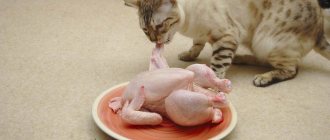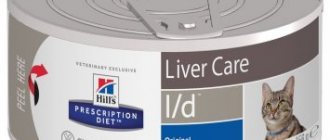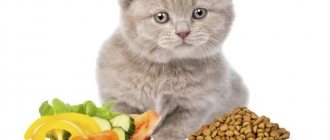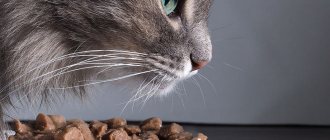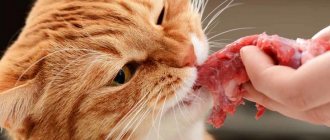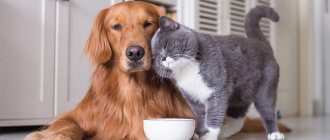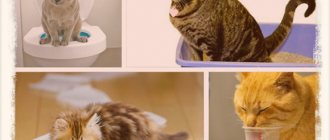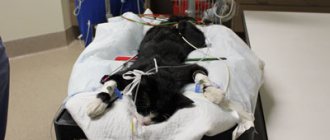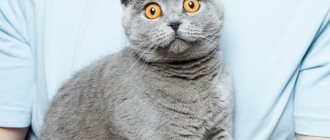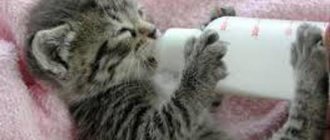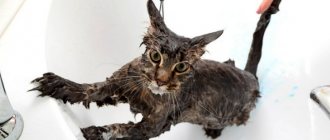A natural diet is preferable for cats than dry or wet ready-made food. But such nutrition must be approached responsibly, since, contrary to popular belief, it will require more time and money. Of course, pets cannot be fed from the table. But, moreover, they should not be given completely raw meat, offal, or eggs. This can lead to health problems. We will tell you what to do with natural products in this article.
About the benefits of chicken meat
It's no secret that chicken meat is considered dietary. It is easily absorbed by the body, so even people weakened after surgery are recommended to first eat nutritious chicken broth, then add white chicken breast meat to the diet.
The big advantage is that chicken meat is inexpensive and cooks quickly. The product contains a large amount of easily digestible protein, and the tender consistency of the meat is liked not only by people, but also by pets. It is provided by a minimal amount of connective tissue. The digestibility of chicken meat is 90%.
Chicken has two types of meat: white and red. Chicken breast meat is commonly called white. It contains less fat and more protein, and is considered dietary because it is low in calories (about 110 kcal per 100 g of product). But veterinarians do not recommend feeding your cat only white meat. Yes, it contains more magnesium, but red contains no less important microelements - iron and zinc, as well as vitamins.
Chicken meat contains vitamins necessary for any living organism, including A, group B (B1, B2, B4, B5, B6, B9 and B12), C, D, E, K, PP. In addition, chicken contains:
- calcium;
- magnesium;
- phosphorus;
- potassium;
- sodium;
- iron and other trace elements.
The rich composition of nutrients allows veterinarians to recommend feeding domestic cats chicken meat - not only the breast, but also other parts of the carcass. However, it is strictly forbidden to give skins and long bones to your cat. Leather is poorly digested in the stomach of pets; moreover, it contains a lot of fat and, if eaten regularly, even in the healthiest cats, will eventually cause problems with the liver, pancreas, and gall bladder. When chewed, tubular bones break into sharp fragments. They can injure the intestines, so they are prohibited for cats.
Chicken for kittens as a permanent food
To the question “Is it possible to feed chicken meat to kittens all the time?” Experts give mixed answers. But they adhere to the fact that in the first three months of life the diet should remain unchanged. Other products are added gradually and in small portions, but chicken meat must be present. You can replace it when the kitten grows up and adapts to heavier products.
Boiled or raw chicken meat is good for kittens for complete nutrition. It is cheap, accessible and easy to digest. If you follow all the rules, your pet will be happy with this dish and will grow up healthy and happy.
Should I give raw or boiled meat?
Cats are carnivores, and in the wild no one cooks food for them, so the digestive system of pets can handle raw meat quite well. Therefore, such food is physiologically closer to cats. Another thing is the individual preferences of animals, which depend on what food the animal has been accustomed to since childhood.
Chicken meat is extremely rarely infected with helminths, so in this regard, a cat eating raw chicken is not in danger. Fish and other types of meat pose a great danger - for example, pork, which veterinarians generally do not recommend giving to cats.
Much more dangerous is the possible infection of a pet with salmonellosis. The causative agents of the disease are Salmonella - bacteria that remain active for a long time and are practically insensitive to low temperatures. But at +75 degrees, pathogenic microorganisms die. A 10-minute heat treatment will be enough to kill germs. A side effect of this treatment is that some of the nutrients are lost. The conclusion suggests itself: cats can have raw chicken meat, but only if it is purchased from a trusted seller and has been tested for salmonella.
Why is salmonellosis dangerous?
Salmonellosis is dangerous not only for cats, but also for humans. And more than a third of domestic animals with strong immunity that have eaten meat contaminated with salmonella will forever remain carriers of the pathology. The weakened body of a cat (small kittens, elderly animals) may not be able to cope with the infection.
The disease is always severe and accompanied by severe symptoms. You can observe in your pet:
- refusal of food;
- attacks of high fever;
- increased body temperature;
- apathy;
- diarrhea, feces have a dark, almost black color and a foul odor, and may contain streaks of blood;
- frequent vomiting with foam;
- cough;
- labored breathing.
The cat may experience severe pain in the abdomen, does not allow it to be touched, and shows aggression. With salmonellosis, the permeability of the vascular walls increases, which accelerates the penetration of pathogenic microorganisms into the body. Without prompt veterinary care, kittens, animals with low immunity and elderly animals die within 1-2 days from dehydration or sepsis.
How to give: the best recipes
It is useful to give your pet boiled breast with carrots and broccoli.
Cat owners recommend preparing the following simple chicken dishes for natural-fed pets:
- Chicken with vegetables. The breast is boiled and chopped. Add steamed broccoli and carrots in equal proportions. Then a small amount of fresh broth is introduced.
- Liver with garnish. Finely boil and chop 400 g of offal with the addition of 2 tbsp. l. olive or sunflower oil. Add 200 g of steamed oatmeal and 50 g of steamed green peas.
- Kidneys in sauce. Boil and chop 200 g of chicken kidneys. Add 4 tbsp. l. prepared oatmeal and ¼ cup grated carrots. Melted butter of medium fat content - 30 g is poured on top. Then 70 ml of yogurt without additives is added.
- Nutritious breakfast. Boil 70 g of rice. It is better to use unrefined, as it improves intestinal motility. Combine 1 boiled chicken egg in one plate, 1 tbsp. l. chopped carrots and boiled green beans and 20 g of chopped chicken fillet. 3 tsp is introduced. olive fruit oils.
If your cat previously ate exclusively dry food, raw chicken may not be of interest to her. Veterinarians advise boiling it and adding treats that your pet loves.
For babies and older cats, veterinarians recommend placing cooked food in a blender to facilitate digestion and prevent constipation. It is not enough for cats to eat meat in its pure form; the menu must be supplemented with sources of carbohydrates and fiber - bran, vegetables or fruits.
Is it possible to give heads and paws
Chicken can be the basis of your pet's diet, but you should not feed it chicken breast alone. Already from 3.5-4 months of age, kittens can be given chicken legs, and by about a year - and heads by removing the beak.
Benefits of chicken heads:
- scallops and eyes contain collagen, a component of protein;
- the brain is a source of fat and B vitamins;
- The soft bones of the head ensure the supply of calcium to the cat’s body.
Cats need bones because they are a good source of calcium and phosphorus. By chewing chicken heads, the cat trains its chewing muscles and strengthens its gums.
Important!
It is not recommended to give boiled bones to cats - they clog the animal's digestive tract.
It is recommended to give chicken heads to kittens - during the growth period they need to ensure that their body receives a sufficient amount of protein, fats, and beneficial microelements. Pregnant and lactating cats will benefit from calcium and phosphorus, contained in sufficient quantities in chicken heads.
However, they should be given to pets carefully - no more than one head per meal. Overeating can lead to problems with the digestive system. In addition to heads, you can give cats chicken by-products: liver, kidneys, lungs, hearts.
Important!
Cats usually love liver, but it is best to give it no more than once a week. More frequent consumption of liver negatively affects the appearance of the animal and the quality of the coat.
Kittens and adult cats, as a rule, are reluctant to eat other offal products. Therefore, they are rarely included in the diet of pets. If the cat does not refuse such food, you can give him chicken hearts instead of meat once a week.
Raw chicken
Before introducing complementary foods, many owners have a question: “Is it possible to give raw chicken to kittens, and what could be the consequences?” The answer will be ambiguous, because everything depends on its quality. For example, cats and chickens do not share parasites, which is why it is considered safer in its raw form. But the chemical composition of homemade meat will differ from that from a poultry farm.
Products from poultry farms are often saturated with growth hormones, antibiotics and harmful substances. It can be affected by salmonella, E. coli and other infections. Therefore, it is best to cook it before use.
Homemade products, on the contrary, are chemically safer and suitable for feeding kittens. But, if the chicken ran through garbage dumps or came into contact with sick animals, it is possible that it will be sick or with parasites.
You can feed your kitten raw chicken, but you should only buy meat from producers you trust. If it is not possible to buy a high-quality, proven product, then boiled or half-raw chicken is best. To destroy most of the bacteria in raw chicken, it is doused with boiling water, frozen in the freezer for 3-4 days, and then cooked. Complementary feeding begins with boiled meat, and after the intestines have adapted, they are given half-raw and raw.
The importance of meat in the diet
In the wild, raw meat is a basic component of the diet of carnivores. By consuming it, animals provide themselves with the energy they require for full development and growth. Meat is a valuable source of amino acids, which play a decisive role in the formation of muscle tissue. One of the most important amino acids for the cat's body is taurine.
Taurine deficiency leads to deterioration in animal health, blindness, hair loss, and the development of cardiovascular and endocrine diseases. This amino acid is essential for cats, so it must be included in modern food. Products containing vegetable protein are not able to compensate for the lack of substances of animal origin. They are less easily absorbed by the cat's body, so they cannot replace sources of animal protein. In addition, foods rich in plant protein do not contain taurine.
Processing methods
Heat treatment is the main method to make a product safe for consumption. This treatment can be either heat or cold.
- Cooking is a type of heat treatment of meat that allows you to destroy potential sources of danger (helminth eggs, pathogens of infectious diseases). To process the product, it must be divided into small pieces and boiled in boiling water for 5 minutes.
- Scalding also reduces the likely risk of your pet becoming infected with helminths and intestinal infections. With this type of processing, the meat must be cut into small pieces and doused with a copious stream of boiling water several times.
- Freezing is a type of heat treatment of meat that reduces the likelihood of your pet becoming infected with intestinal parasites. For complete processing, the product must be kept in the freezer for at least several hours. More reliable processing results are provided by freezing for 2–4 days.
How much meat should I give my kitten?
Raw meat for 1 month old kittens is served in a bowl directly into the nest. The mother eats the same food as her kittens. They look at their mother and learn to do everything right. The lactating female is not limited in food: she is allowed to eat several times a day. Let mom eat enough. And kittens will not eat too much meat, because... their main food is still milk. Meat in this case is just training for now.
Raw meat for kittens at 2 months already becomes a complete meal. At this time, they switch to their own provision, gradually abandoning their mother's milk. At this time, the breeder feeds them either natural food, industrial food, or a mixture. Many breeders prefer the mixed version, because... It is unknown what exactly the kitten will eat in its new home. If this is a different type of feeding, then he may develop digestive problems - and the buyer will file a claim with the breeder.
EXPERT COMMENT: CANDIDATE OF BIOLOGICAL SCIENCES GALINA CHILIKINA
“If the nursery fed only one natural female, and the new owners want to switch it to dry food, very serious digestive problems may arise, since aggressive enzymes will be released with the gastric juice, necessary for digesting meat, which are not needed for drying. If, on the contrary, the kitten in the nursery was fed exclusively dry food, and its new owners want to switch it to healthy natural food, the kitten will experience a phenomenon such as an inability to digest this food, since the stomach does not produce the enzymes necessary for this, so the kitten will constantly regurgitate this food, which may be perceived by the owners as a pathology. Diarrhea and other phenomena are also possible.”
Raw meat for kittens at 3 months is already the main food. From 3 months, most have lactose intolerance: due to the large amount of milk, pets can become bloated and diarrhea.
Article continues after advertisement
Small kittens are not limited in the amount of food they eat, giving meat several times a day. But you shouldn’t let them eat a lot at one time. The daily dose is approximately up to 10% of the kitten’s body weight.
At 3 months, many kittens already find a new home, and owners cannot always feed them several times a day. In this case, it is not necessary to switch to dry food, which is always available. A three-month-old kitten can already be fed raw meat like an adult animal: twice or thrice a day, also in a total amount of up to 10% of body weight.
For more information on how often to feed raw meat to your kitten, follow this link. The article indicates feeding standards for Scottish kittens, but the feeding principles described are valid for any breed.
How to feed your cat properly with natural food
Which of these do you think will be beneficial for the cat?
The basis of the animal's diet should be meat. Doctors advise feeding your pets the following meat products:
- Beef and veal.
- Chicken and turkey.
- Rabbit meat.
- Sea fish is not oily.
- Meat purees with vegetables for children.
Some cats love boiled vegetables. It is very useful.
Vegetables are also good for animals. It’s true that not all cats love them, but if you introduce them into your pet’s food correctly, he won’t even notice that they are there. Among the most useful vegetables are:
- Carrots and beets.
- Cauliflower and salad.
- Zucchini and pumpkin.
Your cat's diet should not contain tomatoes or eggplants, as they contain harmful substances for your pet's body. If your pet doesn’t mind simple vegetables, then you can give them raw and add a little vegetable oil. If you refuse them, vegetables are added to meat foods.
Dairy products
Caught in the act!
Fermented milk products such as:
- Kefir, fermented baked milk.
- Yogurt.
- Not fatty cottage cheese.
- Hard cheese without additives.
- Semolina, oatmeal.
Other products for a healthy diet
Cat and egg yolk
Other products that are useful for your pet and necessary for the proper functioning of his body:
- Egg yolk.
- Rice, oatmeal, wheat porridge mixed with boiled or frozen meat or fish.
- Greens (dill, parsley, oats, wheat).
- Vegetable oil.
- Vitamins and minerals.
- Purified or boiled water.
The egg yolk must be boiled. It can be given either separately or as an additive to cottage cheese and porridge, but not more than twice a week. Porridge for a cat should be prepared based on a ratio of 1 to 2, that is, one part of porridge and two parts of meat. You can add finely chopped dill or parsley to the same porridges. You can buy oats and wheat at a pet store or grow your own.
When feeding natural food, do not forget about vitamins
Vegetable oil can be added to your pet's food no more than 2 teaspoons per day. Vitamins are sold in pet stores in the form of tablets or various goodies; they must be given to the cat every day.
Water is one of the main elements a cat needs for the normal functioning of its stomach. The drink in the bowl should always be clean, and it should be changed as soon as it gets dirty.
How to process it?
Raw meat is dangerous because it can introduce parasites into the cat's body. If you do not attach importance to this and do not treat an animal infected with helminths, even death is possible. When we prepare meat for ourselves, we heat it - boil or fry - and this kills the parasite eggs. But fried meat is strictly forbidden for cats, and boiled meat is digested by them much worse than raw meat, it is not as nutritious and not as healthy. What to do?
One of the best ways is to freeze meat. It should be divided into portioned pieces (for one feeding), put these pieces in plastic bags and put in the freezer
You can buy special bags for breakfast, or you can use regular ones, it’s not so important. Plastic vacuum containers are very convenient to use, since there is no risk that they will freeze to each other or to the meat, as often happens with bags
Severe cold can also destroy parasite eggs, which to some extent will protect your purr.
Before each feeding, you will need to remove another bag from the freezer, defrost the meat and give it to the cat. The juice that will be released during defrosting can also be poured into the cat's bowl; many cats love it.
There is no need to make minced meat; it is more convenient for a cat to eat it in small pieces. You can defrost meat in a microwave or microwave oven, then some heat treatment will be added to the freezing.
Cheese-related products
Having heard the term, a person imagines a yellow dense piece with holes. But cheese is called different products. In English the word additionally means:
Cats like all these dishes. Breed does not affect preference. Elite pets and yard dwellers show interest in cheeses. Animals can literally snatch a milk-coated sandwich from a person. The decision to share with your pet depends on the composition of the product.
Potentially Hazardous Components
Cats and people perceive biological substances differently. Onions (tuber and stems) and garlic are dangerous foods that can cause the breakdown of red blood cells. Not found in regular cheeses, they are potential additives for brushes, processed foods, and pet-attracting flavorings.
Other potentially hazardous ingredients include:
Mold – you should not give elite cheese to cats. Microorganisms can disrupt the bacterial balance of the intestines. A product that has become more expensive in the refrigerator should not be eaten by the animal or its owner.
Dyes. Stores offer colorful cheeses, colored by natural additives: tomatoes, lavender, herbs. Natural and synthetic pigments are potentially dangerous for cats. Natural dyes will provide a rich shade due to their high concentration. Spices and nightshades (tomatoes) are potential toxins for cats. Synthetic pigments tend to accumulate in the body, affecting the functions of internal organs.
Flavorings, taste enhancers. They are addictive, can cause allergies and other unpleasant consequences.
Homemade dairy products pose additional risks. Raw cottage cheese (cheese cheese) may contain pathogens, manufacturer. Having caused indigestion in a person, it can cause serious poisoning and damage to internal organs in a pet.
So can cats have cheese?
The diet of animals was formed in ancient times. The cat's diet is based on animal proteins and fats. Modern feeds take this need into account. Although veterinarians recommend sticking to a single diet (dry foods or natural), you can combine prepared foods with reward treats. Cheese is one of the rewards.
Best articles: Which continent is the lowest on the planet?
Products from this group are popular with many mouse catchers. When deciding whether cats can have cheese, it is worth finding out about their lactose sensitivity. Animals' bodies produce few enzymes that break down cow's milk, the main ingredient in cheeses. Nature did not provide for its perception in cats.
Pets love dairy products - a source of fats and proteins. But the substances coming from the cow are poorly absorbed. Humans also have problems.
Lactose-free products are suitable for cats. Manufacturers offer cheeses and paste-like masses that do not contain an unpleasant substance. For their production, soybeans and other organic raw materials are used.
Cats can better tolerate goat, sheep, and other milk products
When choosing cheese with a minimum of lactose, you should pay attention to:. These products can be given to cats as treats, rewards (up to 1-5 g per day)
Spreads will be an additional reward. Their consumption should be limited due to the abundance of preservatives and flavorings
These products can be given to cats as treats and rewards (up to 1-5 g per day). Spreads will be an additional reward. Their consumption should be limited due to the abundance of preservatives and flavorings.
Cottage cheese and feta cheese are given to pets from trusted manufacturers. You should not offer animals unknown products without heat treatment.
Cats can eat cheese. It is not included in the main diet, but animals like it because of its composition: proteins, fats, flavors. It is better to offer your pets natural products. Cats love feta cheese, cottage cheese, and their derivatives belonging to the “cheese” category.
Such products are given to animals from trusted suppliers. Industrially produced cheese should not contain mold, spices, or large amounts of lactose.
Cats can be given different types of dairy products, observing their reaction. So the owner will choose the optimal additions to the diet.
https://natworld.info/domashnii-zhivotnye/mozhno-li-davat-koshkam-syrhttps://koshek.ru/mozhno-li-koshke-davat-syir.htmlhttps://lovecats.ru/mozhno-li- koshkam-syr/
Meat for castrated and sterilized
As you know, it is very important for cats after sterilization and cats after castration to choose the right diet for feeding. After such operations, great changes occur in the animal’s body, metabolic processes slow down. With improper feeding, there is a high probability of developing certain diseases that significantly worsen the general condition of domestic cats.
After sterilization, cats can be given lean meat, but only in raw and frozen form! The boiled product is not particularly beneficial for the body of operated animals. In addition, boiled meat can provoke protein intoxication, a very dangerous condition for cats.
Portions must be dosed and served fresh. You can also add some types of offal in small quantities to the menu.
After castration, cats can also eat raw lean meat after preliminary freezing. Fractional meals in small portions are encouraged, up to 5-6 times a day.
The cat should not be given a supplement, even if he really asks for it. The restless appetite of a castrated animal often leads to obesity, as a result of which the cat develops other unpleasant health problems.
What kind of chicken is best to give to cats?
Factory-bred poultry can be raised on various chemical additives. Also, in order to increase the sales period, unscrupulous sellers treat meat with special chemical compounds. Animals have a more developed sense of smell, so they will only eat “bad” food when they are very hungry.
In general, if you are thinking about whether you can give chicken to cats, you should give preference to poultry. It is better to purchase meat from farmers. Based on your pet’s behavior, it will be clear who has the best chicken and where to buy it.
However, an animal’s refusal to eat meat does not always indicate a low quality product. Many cats prefer fish. I especially like sea gobies. This is a more budget-friendly food option. Contains a large amount of protein, iodine, phosphorus.
Can a cat have chicken with bones? Tubular bones can damage the stomach, although, as mentioned earlier, in the natural environment the entire bird carcass is eaten. Only the feathers and beak remain. In general, if you doubt whether your cat can eat chicken and whether he will like it, just treat your pet with a dietary treat!
What to do before serving
There are three main ways to secure meat:
- Cooking. In this case, the meat is boiled for about 5 minutes.
- Scalding small pieces with boiling water.
- Deep freeze. The only way that allows you to leave the meat raw. To do this, cut it into pieces and place it in the freezer for 4–5 days (at least 48 hours). The helminth eggs die. The pieces do not need to be made too small: when a cat bites off and gnaws food, it simultaneously produces gastric juice. The meat is cut finely (about 1.5x1.5 cm) only for those animals that in a hurry swallow it almost whole.
Can kittens have boiled meat?
Does a kitten need to cook meat? No no need. He, being a predator, does not need this. Yes, the kitten looks weak and fragile. But that's what you think until you put a piece of raw meat in front of him.
And, nevertheless, kittens can also have boiled meat, it is not poison. However, such nutrition has a number of disadvantages. Firstly, it, as we have already written, is almost completely devoid of useful substances. On a boiled diet, a kitten has to add special vitamin and mineral complexes to its food, which are expensive and often do more harm than good. Secondly, boiled meat is dehydrated, meaning that eating it in large quantities creates a risk of constipation. Thirdly, it is raw fiber that helps adjust the kitten’s digestive enzymes in the right way.
Well, if you only occasionally want to treat your cat to a piece of boiled meat, that’s okay. The main thing is that the basis of the diet is raw.
Signs of salmonellosis in cats
If you feed your cat raw chicken, carefully monitor its condition. If she suddenly developed :
- diarrhea (usually with blood); - the temperature has increased; - weakness and apathy developed; - vomiting began; - Appetite has deteriorated greatly.
Contact your veterinarian immediately .
Firstly, because a cat can die due to salmonellosis, and secondly, because it can infect people who come into contact with it.
